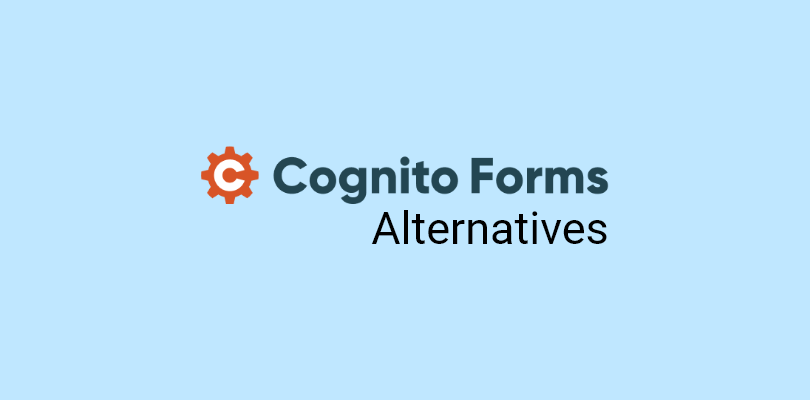
Have you ever hesitated to include demographic questions in a survey, unsure whether asking about age, gender, or income is appropriate—even if responses are anonymous? You’re not alone.
Many people, including your customers, are cautious about sharing personal details. Yet, demographic questions are vital for gaining a deep understanding of your customer base.
These questions collect crucial information about age, income, education, and location, shedding light on the factors that influence your customers’ purchasing decisions.
In this blog, we’ll explore the nitty-gritty of demographic surveys along with tried-and-tested strategies of creating an effective demographic survey questionnaire. Armed with this data, you can tailor your business strategies to meet the diverse needs of your audience more effectively.
Let’s begin.
What Is a Demographic Survey?
Demographic surveys collect your target audience’s personal details. It helps you to analyze their tastes and preferences. What is your customer’s gender? Do they prefer to buy from the local store or order online? How much do they earn? Where are they located?
These demographic questions give a thorough understanding of the target market segment.
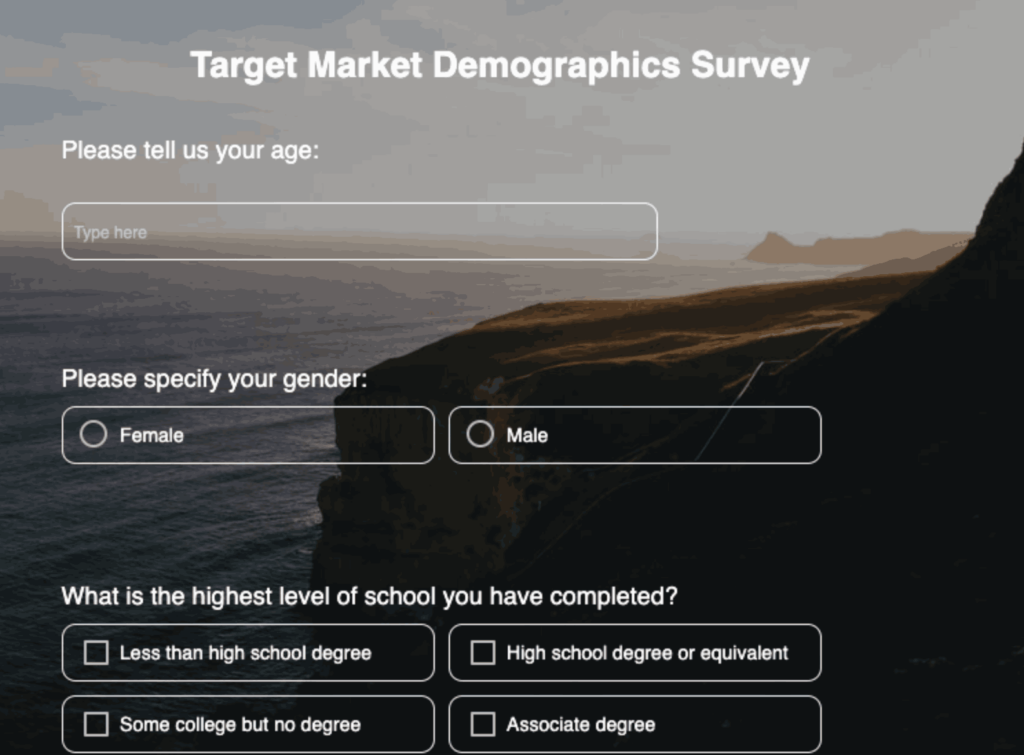
Once you know the underlying trends, it is easy to target profitable audiences as opposed to a generalistic audience.
Also, knowing the real preferences of your audience helps you to offer them quality service. Demographic questions help you build the customer personas, thereby enabling you to understand their queries better. Remember, a happy customer is a returning customer.
10 Examples of Standard Demographic Survey Questions
1. AGE: Gauging Purchase Probability

Age is an essential factor to consider while conducting surveys. Your customers’ age reveals crucial information like food habits, purchasing patterns, dependency, lifestyle, etc.
These details are necessary to deduce the probability of them buying your product.
But, are you asking the right ‘age’ questions?
For instance, if you ask, “What is your age?” it is straightforward and personal. Most of the survey respondents will be reluctant to answer it.
Let’s rephrase the question in an impersonal way – by putting the options in a group!
The age group is a convenient and non-intrusive way to frame the questions. Always give them the flexibility to not reveal their age. In this way, you can keep them engaged and prevent them from dropping off the survey.
Pro tip: Do not include the same age group in 2 different options,
- 18-25
- 25-50
Herein, a respondent could mark both (a) and (b) for age 25, resulting in the duplication of the answers.
2. GENDER: “What Is Your Gender?”

Gender preference gives a clear picture of your business trajectory. Different genders prefer a product/service for various reasons, and the reasons help you align your business costs.
For instance, LinkedIn is a popular professional networking site that connects people from different working backgrounds. As a brand, you can analyze the LinkedIn demographic data concerning ‘gender’ to build your business’s good visibility on social media.
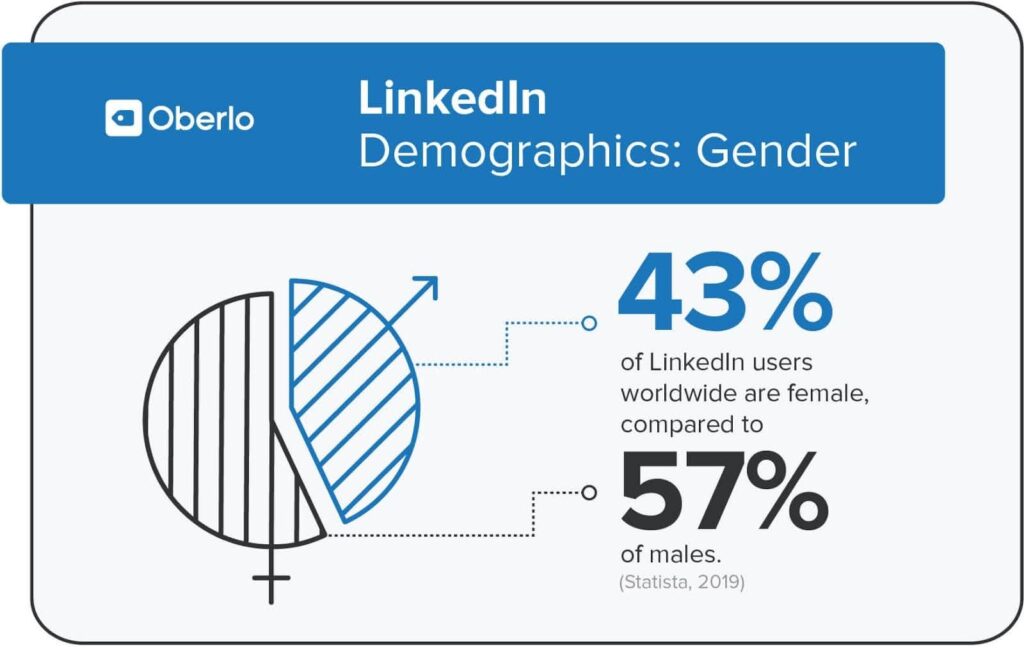
But, gender is a sensitive yet fundamental question in any demographic survey. Ensure that your surveyees are comfortable answering gender questions. Also, give them an option not to reveal their gender.
Demographic Question Example Based on Gender:
Lastly, do not confuse gender and sex. While sex is biologically defined, gender is based on self-identity. Gender brings in better clarity with a personal touch.

3. ETHNICITY: “What’s Your History?”
Ethnicity questions gather information about your customer’s background: their history, culture, or nationality. These queries showcase the nature of their purchasing choices.

Different cultures have different practices that guide their decision-making process. By understanding these choices, you can better empathize with your customers’ needs.
Let’s take a look at an example:
A study by Statista provides a breakdown of Internet users in the US in 2019. This data is handy if someone is conducting market research for a telecom business. Including the specified ethnic groups while promoting the brand is likely to increase inclusivity and, in turn, more engagement.
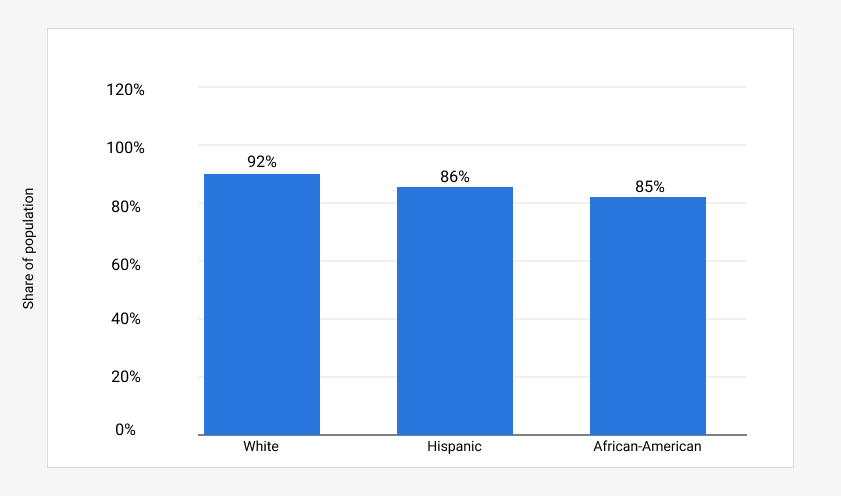
Pro tip: Keep the option open for ‘nil answer.’ Not all of your customers will be aware of their ethnicity. Make sure that their choices are respected.
4. LANGUAGE: “What is Your Mother Tongue?
“To have another language is to possess a second soul.” – Charlemagne
Language is a significant factor that creates an instant bond between you and your customer. It is human nature to have an affinity with the same language, people, place, culture, etc.

In contrast, language differences reveal your customers’ varying needs. If you are successful in tapping into your customers’ needs through language, you can build a lifelong relationship with them.
With versatile languages, you can stay ahead of the competition and ensure a successful business.
5. MARITAL STATUS: “Are You Married/Unmarried?”
Marriage is an essential yet sensitive question to include in your demographic survey. Marriage lets you know the size of your customer’s family. The number of people dependent on the customer influences their buying patterns.

Marital status also provides valuable insights into consumer behavior and economic stability. Whether someone is married, single, divorced, or widowed can influence their spending habits—married couples might focus on long-term investments like homes, while single folks might spend more on personal leisure activities. Plus, understanding marital status helps gauge social and emotional health trends, which is essential for public health planning.
This data also helps craft targeted marketing strategies and understand cultural shifts, making it invaluable for both businesses and policymakers.
6. EDUCATION: “What’s Your Degree?”

Questions on education reveal your customer’s academic background. Further, by deducing their skills, you can create an appropriate business pitch. For example, a customer with a science degree requires an analytical pitch, while an emotional pitch suits a participant from an arts background.
Case Study:
Kaggle, a machine learning and data science community, conducted a demographic survey on its customer base. This survey data reveals the customer’s skill level, i.e., their aptitude for machine learning and coding. The results showcase that customers with master’s degrees come on top, forming the target audience.
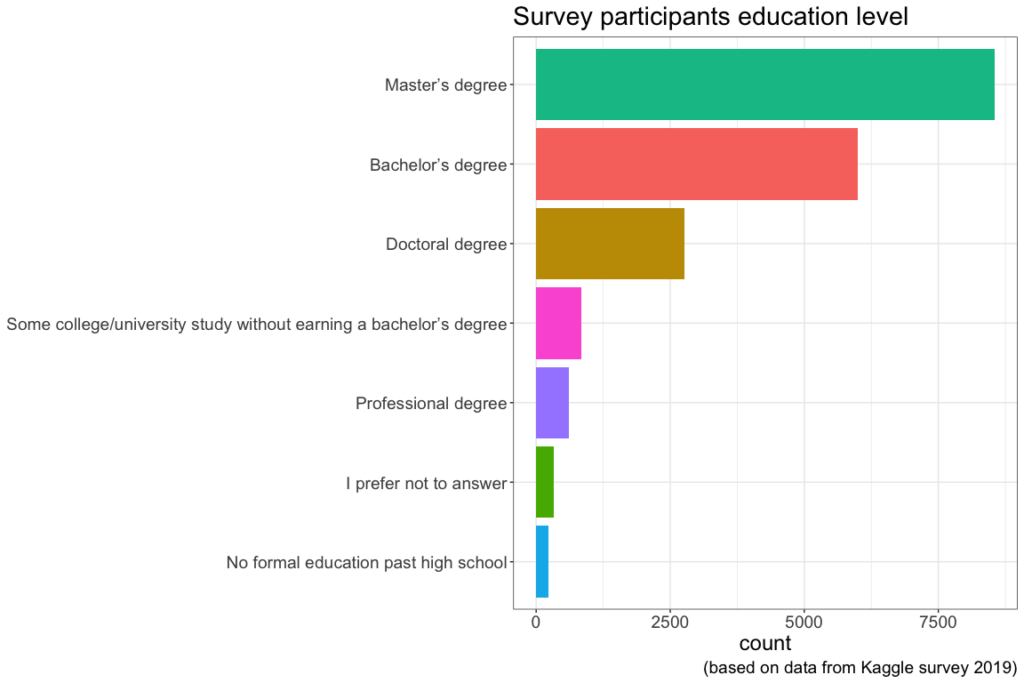

7. EMPLOYMENT STATUS: “What Do You Do for a Living?”
Your survey participants’ employment status is crucial for gauging their spending power. Without the requisite purchasing power, they may not be able to buy your products.



However, this question requires caution. Not everyone is comfortable answering this question, especially those searching for new jobs.
Case Study:
KPMG, a multinational professional services network, surveyed US consumers to determine their employment status during COVID-19.
Here’s what they found.
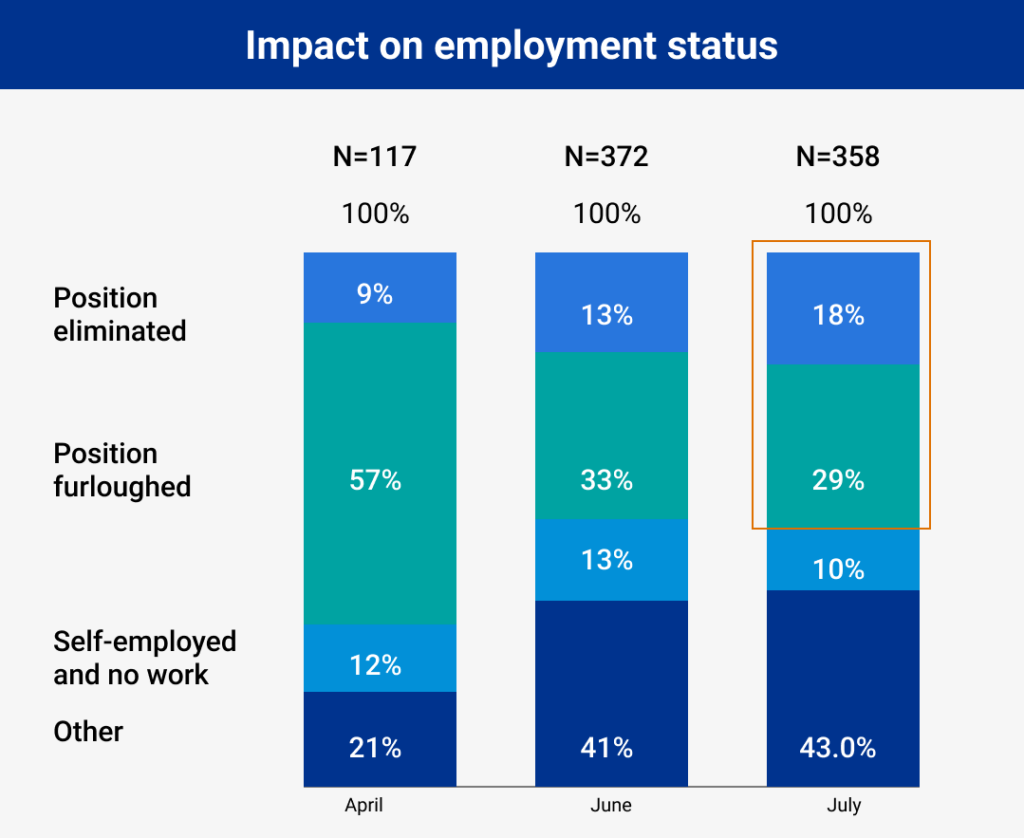

As we can see from the survey, a staggering 57% of people were laid off from their work. This indicates that their buying capacity has reduced. As a brand, you need to come out with revamped business tactics to lure these customers, for instance, offer them discounts.
8. HOUSEHOLD INCOME: “What is Your Earning?”
Gauging your participant’s household income shows the number of dependents or independents in their family: the more dependents, the less your customer’s purchasing power.


Also, make sure that you ask the sensitive question by including a range. Not everyone is comfortable sharing the exact salary.
Case Study:
A survey of US Household income shows the purchasing power of US citizens. You can use the survey results to form a basic understanding of your customer base.
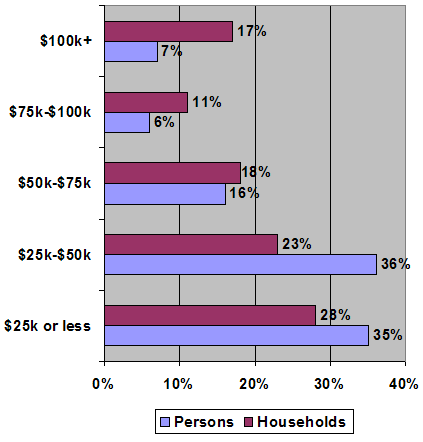

9. LOCATION: “Where Do You Live?”
Your customer’s location forms a significant part of your demographic survey. The place gives you an insight into their living conditions and status.


Not every customer lives in an urban area with good transportation. Maybe your customer is put up in a remote location, and they cannot afford your products due to transportation woes.
In that case, you can include local store delivery to encourage them to purchase your products.
Case Study:
Urban Demographics Survey by Centreforcities shows the preferred living location of US citizens. It will help you analyze the needs and choices of your customers.
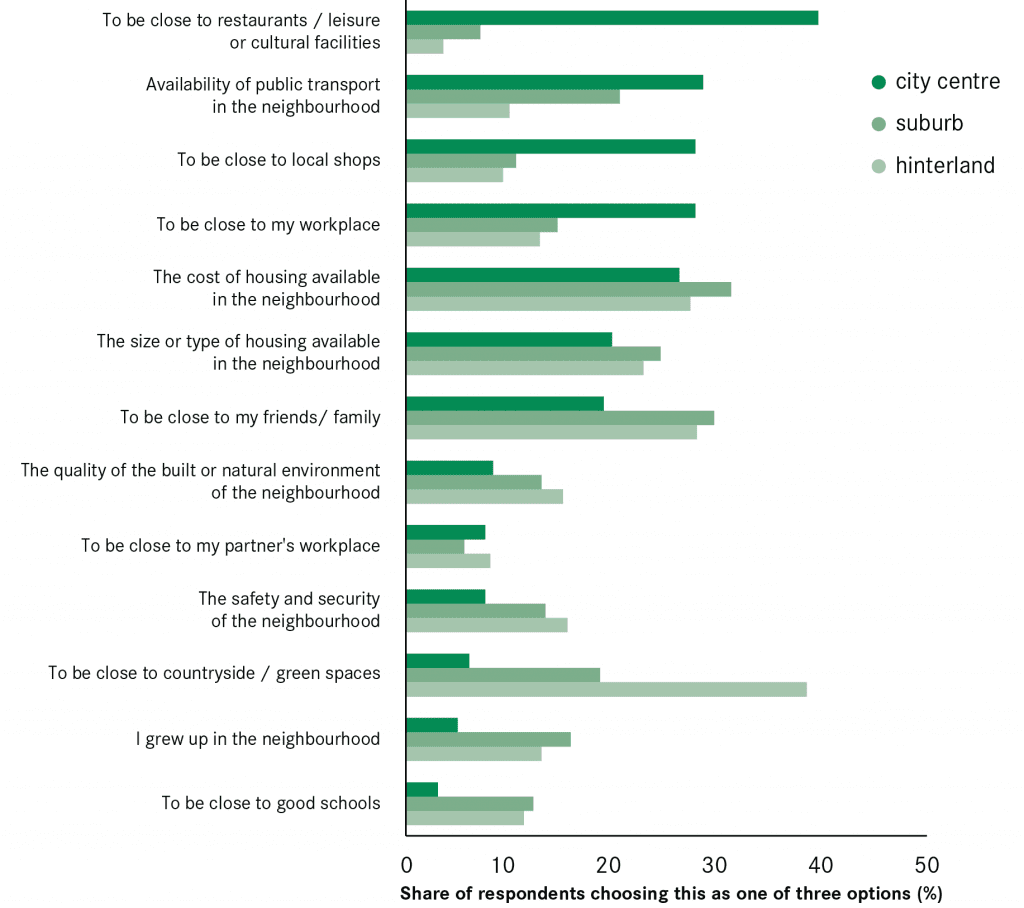

10. FAMILY SIZE: “How Big Is Your Family?”
Family size is an indicator of the number of dependents in your survey respondents’ families: Do they have children, or do they have elderly relatives to care for? This affects their choices and preferences. For example, the elderly have different food preferences than children. Hence, these factors influence your customers’ food choices.
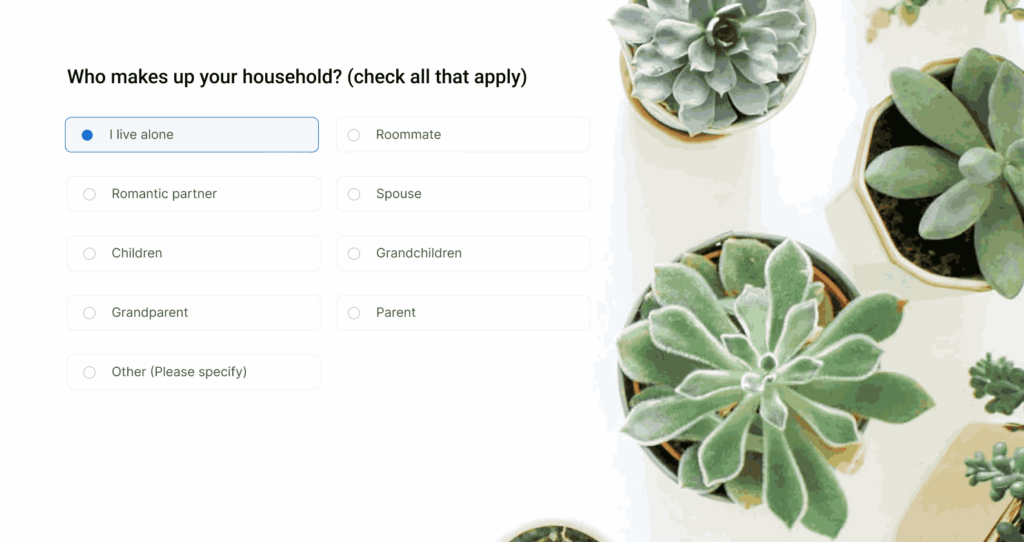

Similarly, your customers invest a significant amount for children’s educational needs. You can then specifically tailor the campaign to woo your target customers.
Case Study:
A consumer expenditure survey by the US Bureau of Labour Statistics shows that married parents spend twice on their children as compared to cohabiting and single parent households.


Source: Institute for Family Studies
Demographic Questions to Ask in a Survey: By Category
Let’s take a look at some sample demographic questions for a survey based on their categories.
1. General Demographic Surveys
These surveys collect basic demographic information such as age, gender, ethnicity, marital status, and household composition. This type of data helps to identify the characteristics of a population or specific groups within it.
Sample Questions:
- What is your age?
- What gender do you identify as?
- What is your marital status?
- How many people currently live in your household?
- Which race or ethnicity best describes you?
- What language is primarily spoken in your home?
- Do you have any dependents?
- What is your annual household income?
- What level of education have you completed?
- Are you currently employed?
2. Socioeconomic Surveys
These delve deeper into respondents’ economic conditions, gathering data on income levels, employment status, job roles, education levels, and even property ownership. Socioeconomic surveys are crucial for understanding the economic dynamics within a population and tailoring services or products accordingly.



Sample Questions:
- What is your current employment status?
- What industry do you work in?
- What is your job role?
- What is your personal annual income?
- What is your highest level of education completed?
- Do you own or rent your home?
- What is your total household income?
- How many hours per week do you work?
- Do you have any secondary sources of income?
- What is your socioeconomic status?
3. Geographical Surveys
Focused on location-specific data, geographical surveys gather information about where respondents live, such as country, state, city, or even neighborhood. This information is vital for businesses looking to target specific markets or for studies assessing regional differences.


Sample Questions:
- In which country do you currently reside?
- What is your state/province/region?
- What city or town do you live in?
- Do you live in an urban, suburban, or rural area?
- How long have you lived at your current address?
- Are you planning to move in the next year?
- What is your postal/zip code?
- What type of community do you live in?
- How satisfied are you with your current location?
- What are the main reasons for choosing your current location?
4. Cultural Surveys
These surveys explore the cultural aspects of a demographic, such as language, religion, traditions, and values. Cultural surveys are particularly useful for organizations aiming to engage deeply with communities in culturally respectful and relevant ways.


Sample Questions:
- What is your primary language?
- What religion do you follow, if any?
- Which cultural or ethnic group do you identify with?
- How important are cultural traditions in your family?
- Do you participate in cultural festivals or events?
- How often do you engage in cultural activities?
- What cultural values are most important to you?
- How does your culture influence your daily life?
- Do you feel that your culture is represented well in the media?
- What challenges do you face related to cultural integration?
5. Health Demographic Surveys
Health demographic surveys collect data on health-related aspects such as physical conditions, mental health, health services usage, and lifestyle choices. This type of survey is often used by healthcare providers, policymakers, and researchers to improve health outcomes and services.


Sample Questions:
- How would you rate your overall health?
- Do you have any chronic health conditions?
- What types of medications are you currently taking?
- How often do you visit a healthcare provider?
- Do you have health insurance?
- How often do you engage in physical exercise?
- What is your diet like?
- Do you smoke or use other tobacco products?
- How much alcohol do you consume weekly?
- Have you experienced any mental health issues in the past year?
6. Educational Surveys
These surveys gather information about respondents’ education levels, areas of study, and educational institutions attended. Educational surveys can help educational organizations and policymakers improve academic offerings and address educational needs.



Sample Questions:
- What is the highest level of education you have completed?
- Are you currently enrolled in an educational institution?
- What type of educational institution do you attend (e.g., public, private, vocational)?
- What is your current field of study?
- How satisfied are you with your educational experience?
- Have you participated in any form of continuing education or professional development in the past year?
- What were your primary reasons for choosing your current educational path?
- How do you primarily finance your education (e.g., scholarships, loans, out-of-pocket)?
- What are your educational goals?
- Do you have any plans for further education?
What Are the Benefits of Demographic Surveys?
Demographic surveys are incredibly valuable tools that provide a wealth of benefits for businesses, researchers, and policymakers. Here’s why they’re so important:
- Tailored Marketing Strategies: By understanding the age, gender, income, and other demographic details of a target audience, you can create marketing campaigns that speak directly to the preferences and needs of different consumer groups. Instead of throwing arrows in the dark, this precision helps in crafting messages that resonate, increasing engagement and conversion rates.
- Improved Product Development: Insights from demographic surveys can guide successful products and innovations that are aligned with consumer expectations and market demand by highlighting the specific needs and wants of various segments of the population.
- Enhanced Customer Segmentation: By segmenting a market, you simply divide your target audience into clearly defined subsets of customers with similar needs, characteristics, or behaviors. Sounds easy? It is, but it’s also incredibly effective in building more focused and effective business strategies.
- Academic and Market Research: In academia, demographic surveys are crucial for exploring correlations between demographic factors and outcomes in health, education, economics, or social behaviors. For market researchers, this data is key to predicting trends and understanding consumer behaviors, allowing for precise, data-driven decision-making.
- Understanding Cultural Contexts: Entering new markets with increasingly diverse populations? Going clueless is an absolute no-go. Even here, demographic questions can fetch insights into language use, religious practices, and other cultural factors that can potentially affect consumer behavior!
- Equity and Inclusion: Demographic surveys can highlight disparities in access to resources, services, and opportunities. These insights can drive initiatives aimed at increasing equity and inclusion, ensuring that all groups within a society have access to the benefits of economic and social development.
| Read More: How Demographics Surveys Make Marketing Metrics Stand-Out |
5 Tips to Ask the Right Demographic Questions
Use Simple and Jargon-Free Language
Simple survey language makes your survey easy to understand for your target audience. Avoid using abbreviations and jargon, as this distorts their answers. The online questionnaire could be misinterpreted, leading to false results.
Leverage Anonymous Survey
Anonymous surveys help you collect information without obtaining the personal details of the respondents. With anonymity ensured, many respondents will come forward to share their demographic data.
Share the Survey on Easily Accessible Platforms
Make sure that the survey is visible and accessible on different online platforms. Share the survey link on social media, send it through emails, and embed it on your website. Embed it on visible areas like the top bar, a pop-up bar, etc.
Avoid Double-Barreled Questions
Double-barreled questions are confusing questions that do not have a straight answer. When the survey respondents get confused, they either skip the question or give a random answer.
For example, if you ask your customer, “Did you like the quality and quantity of our product?” here, the respondent may have different opinions regarding the options.
Instead, ask them two separate questions: “Did you like the quality of our product?”, “Did you like the quantity of our product?”. This brings in more specificity and clarity to the question.
Bring in Transparency by Explaining the Survey Objectives
Your survey participants have every right to know how the survey results will be used. Ensure that your survey takers are well briefed about the survey objectives right from the beginning. Make it crystal clear whether the survey is anonymous, and inform them about how secure their data is with you to encourage more honest responses.
How to Create a Demographic Survey?
Creating a demographic survey can seem daunting, but it’s really about connecting with people and understanding their stories. Here’s how you can craft a survey that gets to the heart of your demographic and yields meaningful insights.
Define Your Objectives:
Start with the end in mind. What do you need to learn from your demographic? Whether it’s to tailor marketing strategies, enhance product development, or inform policy decisions, having clear objectives will guide your questions and ensure you gather the data you need.
Choose the Right Questions:
Select questions that resonate with your objectives. Include a mix of quantitative (such as multiple choice) and qualitative (such as open-ended) questions to get a balance of measurable data and personal insights. Remember, every question should have a purpose.
Keep it Short and Respectful:
People appreciate brevity and respect. Keep your survey concise to respect respondents’ time, and frame your questions in a way that respects their privacy and cultural backgrounds. A shorter, well-considered survey often yields higher-quality responses.
Test Your Survey:
Before going live, test your survey with a small group similar to your target audience. This helps you spot confusing questions or technical glitches. Feedback from this group can be invaluable, so use it to tweak and improve your survey.
Launch and Promote:
Now, roll out your survey to the full audience. Use your networks, social media, emails, or even embedded website links to share it widely. The easier it is to access your survey, the more responses you’ll likely get.
Analyze and Act on the Data:
Once your responses are in, it’s time to dive into the data. Use statistical tools to analyze the results and translate this data into actionable insights. Remember, the goal of your survey is to make informed decisions that will impact your business or project positively.
Follow Up:
Consider sharing what you’ve learned with your respondents. This not only shows appreciation but also demonstrates transparency. Plus, it encourages participation in future surveys, as respondents see that their input has tangible effects.
Create Effective, Empathetic Demographic Surveys for Maximum Responses
Demographic surveys play a crucial role in winning new customers or retaining existing ones. They help you realign your business strategies for higher growth.
As we wrap up, we hope you’re walking away with a clear picture of their power and potential. Demographic surveys aren’t just about gathering data; they’re about understanding people, refining your approach, and making decisions that truly resonate with your audience.
Whether you’re crafting your very first survey or looking to improve an existing one, remember the insights you gather can open doors to new opportunities and smarter strategies.
So go ahead, take what you’ve learned, put it into practice, and watch as insights unfold and your projects thrive.
Excited to see where your new knowledge takes you? Let’s get started— Schedule a demo and get all your questions answered!
Learn More about Demographic Survey Questions
Where should I include demographic questions in a survey?
Include demographic questions at the end of the survey. This placement prevents respondents from feeling uneasy about sharing personal information right at the start and ensures they are more committed to completing the survey after answering the main questions.
How to ask demographic questions in surveys?
Ask demographic questions clearly and respectfully. Use straightforward language and ensure the questions are optional to respect privacy. Offer multiple-choice formats with a “prefer not to say” option to make answering easier and more inclusive.
What are the advantages of utilizing demographic surveys?
Demographic surveys provide insights into the backgrounds and behaviors of your audience, allowing for better-targeted marketing strategies, enhanced product development, and more informed business decisions. They can also highlight areas for increased accessibility and inclusivity within services or products.
What are some tips to improve survey response rates?
To boost response rates, keep surveys short and to the point, offer incentives for completion, send reminders, and ensure your surveys are mobile-friendly. Clearly communicate the survey’s purpose and how the data will be used to encourage participation.
What demographic questions to ask in a survey?
Typical demographic questions include age, gender, education level, employment status, income bracket, and location. Tailor questions to your survey’s goals to gather the most relevant data for your needs.
How to use surveys to get valuable demographic data?
To get valuable demographic data, design your survey with clear objectives, use a mix of question types, and segment the data based on demographic responses to uncover patterns and trends. Ensure your sampling is diverse to get a comprehensive view of your audience.
What to do with demographic survey results?
Analyze demographic survey results to understand your audience better and improve decision-making. Use the insights to tailor marketing campaigns, develop products, or adjust services to better meet the needs of different demographic groups. Share the findings with stakeholders and use them to inform strategic planning.
Do you want a free Survey Software?
We have the #1 Online Survey Maker Software to get actionable user insights.

